Traditional Dutch Food Christmas Tree Ornaments

This is probably the most original traditional Dutch food blog you ever came across. Why? It was only recently that I discovered how the culinary treasures of the Netherlands have been immortalised in glass Christmas tree ornaments. I can’t think of a better souvenir to bring back from a wonderful trip to Amsterdam, but not before you tried the Dutch delicacies and actually enjoyed them! So, in this blog post I will guide you through the best spots to savour traditional Dutch food and where to find their corresponding glass ornaments, turning your Christmas tree into a tasteful tribute to the flavours of the Netherlands.
About the author: Laura Danielle is co-founder of Comedy Walks: walking tours with a professional stand-up comedian as guide! Amsterdam – Utrecht – Eindhoven
Typical Dutch food ornaments for Christmas tree
I managed to purchase my personal collection of traditional Dutch food Christmas tree ornaments at the Bijenkorf, HEMA, Karwei and GAMMA. At the bottom of this blog post, you will find a map indicating the locations of the stores in Amsterdam where these glass food Christmas ornaments are available. You will notice that the Bijenkorf and the various branches of the HEMA are quite centrally located, while the Karwei and the GAMMA are a little further away from the centre.
Bitterballen
This delicious deep-fried meat or vegan ragout ball is one of the Dutch people’s favourite snacks when they’re enjoying drinks. In the Netherlands, bitterballen are invariably accompanied by mustard, and it’s customary to generously drench your bitterballen in mustard rather than delicately dipping them. Have you ever wondered why the Dutch plant little Dutch flags in their bitterballen or food in general? It is their clever strategy to claim its unmistakable Dutch origin, just in case you were ever in doubt. Once a food item gets the Dutch flag treatment, it is as Dutch as riding a bicycle along a canal while munching on a stroopwafel. These savory treats are a staple at nearly every bar across the Netherlands. In Amsterdam, I’ve lost track of how many bitterballen I’ve had at Café de Waag on the Nieuwmarkt. The bitterballen Christmas tree ornament is available at the GAMMA for €5,99 (£5,23).

Christmas ornament: bitterballen
Kroket
A kroket is essentially an elongated version of a bitterbal. Dutch folks enjoy it as a hearty dinner, often served with fries with mayonnaise, or as a satisfying lunch when squeezed between two slices of bread. Just like its bite-sized cousin, the bitterbal, a kroket is made complete with a generous drizzle of mustard. A kroket sandwich is undoubtedly one of my go-to lunch choices, and you can find it on the menu of nearly every lunch spot in Amsterdam. You can find these ‘bitterballen’ traditional Dutch food Christmas tree ornaments at the Bijenkorf for €16.95 (£14,80).

Christmas ornament kroket
Haring
Haring, or herring in English, is a category in itself. The Dutch eat their beloved herring raw. But before they happily slide a herring down their throat, the herring is prepared the traditional Dutch way. In short this means that gills and guts are removed and the herring is kept in a barrel with salt. How to eat herring in the Netherlands? If you like, you can hold it by the tail and eat it in a few bites. I find it easier to have it cut in pieces and “fork” it up with the little Dutch flag. Herring is traditionally served with chopped onions and/or pickles. You will come across various fish stalls and fishmonger’s shops in Amsterdam. My last herring was from Stubbe at the crossing Singel-Nieuwendijk. Fish stall Frens, close to Koningsplein and the Albert Cuyp Market are also amongst my favourite places for herring. The herring Christmas ornament is available at Karwei for €6,49 (£5,66).
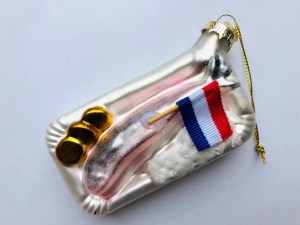
Christmas ornament: haring
Poffertjes
You could describe the typical Dutch poffertjes as small fluffy pancakes or simply as baby pancakes. The Dutch prefer to eat their poffertjes with butter and icing/powdered sugar. I had my last poffertjes fix with my 12-year old niece at the famous flea market at the IJ-hallen. The Pancake Club, close to the main entrance of the Vondelpark, and the Albert Cuyp Market also serve great poffertjes. The poffertjes glass food Christmas ornaments are available at Karwei for €6,79 (£5,93).

Christmas ornament: poffertjes
Drop
The Dutch go wild over their black licorice candy called drop. Although drop comes in many shapes, sizes, colours and flavours, in practice only 4 features matter: sweet, salty, hard and soft. The typical Dutch salty drop is flavoured with salmiac, also known as ammonium chloride, and leaves many travellers bewildered. You can find drop in any supermarket, kiosk, candy store, souvenir shop, petrol station, etc. I’m not particularly fond of licorice, so you’ll have to pick a flavour yourself. But if you do appreciate the salty drop you should reward yourself with this Christmas ornament. You will find these typical Dutch food ornaments for the Christmas tree at the Bijenkorf for €13,95 (£12,17). By the way, zout means salty.
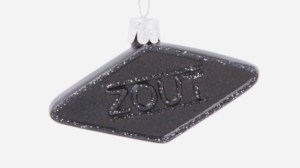
Christmas ornament: drop
Stroopwafel
Stroopwafels, or syrup waffles, are thin round cookies that consist of two layers of waffle held together by a gooey caramel filling. Legend has it that these delightful treats were stumbled upon by a clever baker in Gouda during the 19th century as a creative solution for repurposing his bakery scraps and crumbs. He ingeniously combined his leftovers with syrup, transforming them into an addictive cookie. Today, the stroopwafel is the most beloved and iconic Dutch sweet treat, celebrated both locally, and internationally. In Amsterdam, you’ll encounter numerous vendors offering freshly made, warm stroopwafels. My most recent indulgence in stroopwafels took place at the Albert Cuyp Market and croissanterie Egstorf. You can acquire these typical Dutch food ornaments for the Christmas tree at Karwei for €3.99 (£3.48).

Christmas ornament: stroopwafel
Boerenkool met worst
Boerenkool met worst is a popular winter dish, essentially a hearty combination of mashed potatoes and kale, crowned with a Dutch smoked sausage. It is a relatively cheap and easy-to-make fulfilling Dutch dish that people usually prepare and eat at home. I only know of one restaurant that serves the traditional Dutch hotchpotch: De Blauwe Hollander (at the Leidsekruisstraat), but you may find it on the menu in other places as well (as a day special). You can acquire these traditional Dutch food Christmas tree ornaments at the GAMMA for €5.99 (£5,23).

Christmas ornament: boerenkool met worst
Rookworst
Not really into mashed potato with kale? No worries, you can also buy the famous smoked sausage separately. The HEMA rookworst is a household name in the Netherlands and they have been selling them as a hot take away snack since 1936. Not surprisingly they sell their own HEMA rookworst Christmas ornament for €4 (£3,49).
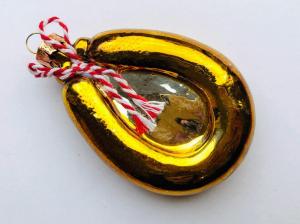
Christmas ornament: HEMA rookworst
Tompouce
The tompouce is a typical Dutch pastry that is composed of 4 layers: a puff pastry bottom, a thick layer of pastry cream, another puff pastry layer and a top layer of pink sugar glaze (or orange sugar glaze around King’s Day). It is incredibly hard to eat a tompouce as the hard puff pastry layers squeeze out the cream when you take a bite. But no worries, the Dutch share all their tompouce-eating strategies on the internet, so look them up if you need support. You can find the tompouce at bakeries and supermarkets. But again, the HEMA tompouce is a household name and they celebrate this with their own tompouce Christmas ornament (€4,50; £3,93). You can also find the tompouce Christmas ornament at the Bijenkorf for €15,95 (£13,92).
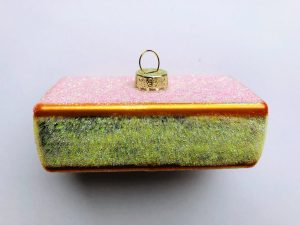
Christmas ornament: HEMA tompouce
Oliebollen
Another deep-fried delicacy is the oliebol (pronounced as o-lee-bol). Oliebol translates literally to “oil ball,” but that robs the oliebol of all its charm so let’s stick to the Dutch word. An oliebol is basically some kind of fried bread as it is made of flower, yeast, sugar and milk. Nevertheless, it is one of the most popular seasonal treats and a staple treat during New Year’s Eve festivities. In less than 3 months, the Dutch, joined by countless tourists, devour over 100 million oliebollen annually. You will find the nicely decorated oliebollen stands or mobile carts around Amsterdam from 1st October till 31 December. Here you can read about the exact locations of the oliebollen mobile carts in Amsterdam. These typical Dutch food ornaments for the Christmas tree are available at Karwei for €4,49 (£3,92).
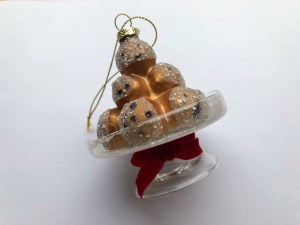
Christmas ornament: oliebollen
Kaas
The Netherlands is famous for producing a wide range of cheeses, including Gouda, Beemster and Edam. The most popular way to cheese in the Netherlands is by slicing it and placing it on a slice of bread. This is a common choice for breakfast and lunch. The Dutch describe their cheeses as “young’, “mature”, and “old”. The differences between these stages of cheese aging are the texture and flavour. With young cheese being soft and mild and old cheese more intense and sharp. Where can you buy the best cheese in Amsterdam? Well, where the Dutch go. Check out the following cheese specialty shops: de Kaashut, Kaashuis Tromp and Fromagerie Kef. This traditional Dutch food Christmas tree ornament is available at the Bijenkorf for €16,95 (£14,79).

Christmas ornament: Kaas
Appeltaart met slagroom
Dutch appeltaart is apple pie at the next level. It is fair to say that the Netherlands serve the best apple pie in the world. Raisins, cinnamon, full-cream butter, there aren’t really any secret ingredients. It could be the sweetened whipped cream (in Dutch: slagroom) on top that sets it aside from any other apple pie you had before. I had my last delicious apple pie with whipped cream at one of my favourite coffee places in Amsterdam: het Stadspaleis. Here you can read more about my favourite coffee places in Amsterdam. Soon I will go on an apple pie tasting journey with Lilly Likes Amsterdam. Let me know if you want to join! The Dutch apple pie with sweetened whipped cream glass food Christmas ornaments are available at Karwei for €4.99 (£4,35).
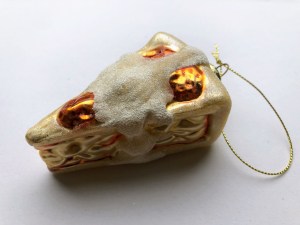
Christmas ornament: appeltaart met slagroom
Map of quirky Christmas ornament stores in Amsterdam
